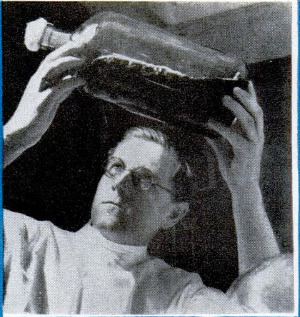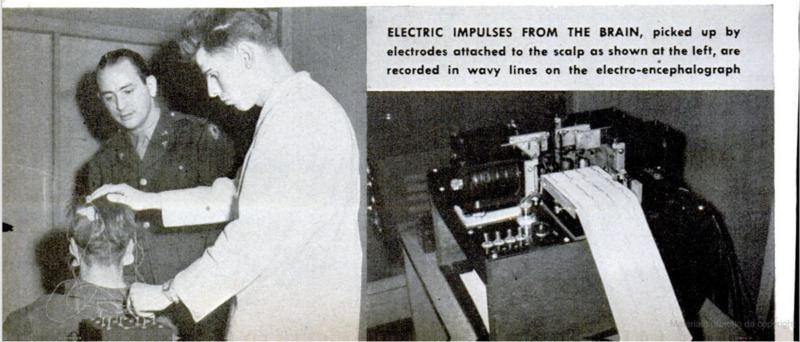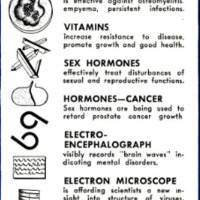-
Title (Dublin Core)
-
Miracles of Medicine in Early 20th Century
-
Article Title and/or Image Caption (Dublin Core)
-
The New Triumphs in Medicine
-
extracted text (Extract Text)
-
WITHIN the short span of the past 80
years more truly great inventions and
discoveries have developed in the field of
medicine than in any comparable period
during the entire history of the science, In
times past, important discoveries often were
followed by long periods of little or no pro-
gressive medical thinking. Today, discov-
erles of the utmost importance are following
quickly on each other's heels.
Among these inventions and discoveries
is an instrument with a moving pen, which
can “take dictation” from a patient's brain.
The record of electrical brain waves that
this amazing secretary takes down is read
by the surgeon for indications of brain
disorders. Another is a drug so powerful that
one part in 25 million parts of water will
stop the growth of bacteria. Still another
has revolutionized the science of diagnosis,
and has completely recast the modern phy-
siclan’s approach to the problem of healing.
Tn this writer's judgment, 10 of the great-
est medical discoveries and inventions of re-
cent years are: The sulfonamides; penicillin;
the vitamins; the sex hormones; the rela-
tion of the sex hormones to cancer; the elec
tro-encephalograph;the electron microscope;
psychosomatic medicine; brief therapy; and
biological thinking.
The sulfonamides are without doubt the
best known of the recent medical discoveries.
And justly so, for no single group of com-
pounds has proved as effective as this one in
preventing and treating such a large num-
ber of diseases. Pneumonia, gonorrhea, ery-
sipelas, childbed fever, many forms of blood-
stream infection, trachoma, septic sore
throat, urinary infections, meningococcus
meningitis, chancroid, gas gangrene, acti-
nomycosis, anthrax, scarlet fever, impetigo
—these are but some of the conditions ef-
fectively treated with one or another of the
sulfonamide compounds.
Equally remarkable and numerous are
the applications of the sulfonamides in the
prevention of infection. Since their first use
in this respect, the lives of countless men
wounded in battle have been saved. The
sulfonamides have also extended the scope
of surgery, heretofore limited by the threat
of infection supervening upon operations in
contaminated regions. They are reducing
the incidence of serious complications which
in times past frequently followed on simple
infections. There is, however, one particular
aspect of the discovery of the sulfonamides
which overshadows even its great practical
results. The sulfonamides have given new
life to the science of chemotherapy—the
treatment of internal disease with chemicals.
Chemotherapy got off to a great start
when Paul Ehrlich discovered Salvarsan in
1910—although for the next 25
years little new appeared on the
chemotherapeutic scene. Then in
1035 came Prontosil, and later the
sulfonamides, and the whole picture
changed. But what changed most
was the concept of chemotherapy
itself. Paul Ehrlich and practically
all of his followers thought of
chemotherapy in terms of “magic
bullets,” that is, in terms of proto-
plasmic poisons which would kill
germs, but not the human body.
Unfortunately few such selective
poisons were found. Most of the
protoplasmic poisons proved as like-
1y to injure the victim as the at-
tacking germs. Then when Pron-
tosil and the sulfonamides were
found to be so amazingly effective
against bacteria, the old theories of
chemotherapy had to be recast, for
the sulfonamides do not belong to
the class of protoplasmic poisons.
Tn fact, the sulfonamides are not
even bactericidal, that is, they do
not directly kill germs. They are,
however, bacteriostatic: they arrest
the development of germs by inter-
fering with their metabolism. By
thus weakening the germs, they
‘make it possible for them to be over-
‘come by the body's own defenses.
Today, research follows the path
of germ metabolism, and seeks to
discover how that metabolism may
be adversely affected by means of
chemical agents. It is this new ra-
tional basis for chemotherapy that
warrants our hope of finding chemi-
cals with which to cure tuberculosis,
leprosy, malaria, and other germ
and virus diseases not affected by
the sulfonamides.
Penicillin
Hot on the heels of the sulfona-
mides came the discovery of pen-
icillin, a chemotherapeutic agent in
many respects superior to the sul-
fonamides. This powerful new drug
is derived from a fungus called
Penicillium notatwm. In 1929, this
fungus, or mold, was an unwelcome in-
truder into some staphylococcus cultures
with which the English bacteriologist Prof.
A. Fleming had been experimenting for
quite some time. Fleming acutely observed
then that wherever the fungus grew, the
germs did not, and he reasoned that the
fungus and the germs did not get along
well together. He studied the matter
further and found his reasoning correct.
However, since the fungus was not antago-
nistic to all germs, but only to certain ones,
he employed it to eliminate from groups of
mixed germs those to which penicillin was
antagonistic. But that was as far as the
matter went at the time.
With the discovery of the sulfonamides it
was natural for the scientists to turn their
attention once again to the penicillium mold.
Another English scientist, Prof. H. W.
Florey, in 1040 extracted from the penicil-
lium mold a brown powderlike substance.
He found it to be an extraordinarily power-
ful drug, effective against a larger variety
of infections than are the sulfonamides.
‘Though but recently discovered, penicillin
has already been subjected to numerous
trials. Unlike the sulfonamides, which op-
erate by diminishing the growth of bac-
teria, it has been found to kill bacteria
or stop their growth entirely. But it will
work in many cases where the sulfa drugs
have proved useless or only partially effec-
tive. Penicillin operates, as the sulfonamides
do not, in the presence of pus and tissue
fluids. This renders it particularly valuable
in the treatment of such conditions as 0s-
teomyelitis, empyema, infected compound
fractures, and wounds and burns with long-
established infections. Penicillin is superior
in undermining the yellow pus-producing
bacteria, the staphylococcus aureus, and
many infections caused by cocel. And the
user of penicillin suffers no toxic effects such
as are sometimes experienced when sulfa.
drugs have been employed.
Unfortunately we cannot as yet produce
‘penicillin in large quantities, and what 1s be-
ing produced has been preempted by the
Government for military use. There is, how-
ever, no reason to doubt that the chemists
‘will ‘before long succeed in crystallizing it
and reproducing it artificially.
The Vitamins
The vitamins represent a major medical
discovery of an order different from any of
those thus far described. Biology and medi-
cine have been radically affected by their dis-
covery. Until vitamins were discovered, the
conviction prevailed among medical men
that there wasn't much one could do about
health except to prevent disease. Doctors
preached personal hygiene in terms of rest,
cleanliness, exercise, fresh air, and good
food. But they did 50 in the belief that they
‘could only preserve health, which for any
given individual was more or less fixed. For
the rest, attention was focused on “fighting
infection” by such means as vaccines, se-
rums, antiseptics, and so forth.
With the development of the modern
science of nutrition, of which the vitamins
are an important segment, we learned that
one could be not sick, but at the same time
not healthy, as in the case of “subclinical
conditions,” in which the patient is mot
‘manifestly ill, but also is far from well. We
also discovered that susceptibility to many
types of disease, including infections, was
due to malnutrition, and that growth, de-
velopment, and aging were profoundly in-
fluenced by the quantity and quality of the
foods eaten.
As our knowledge of nutrition increases,
and as that knowledge is applied to the ev-
eryday diet of people, we are bound to see a
reduction in the incidence of disease, and an
improvement in physical growth and well-
being.
The Sex Hormones
The discovery of the sex hormones is one
of the achievements of modern medicine on
Which the public is comparatively unin-
formed. Yet it is truly a tremendogs ac-
complishment. ¥
It was a bright hunch that led to the dis-
covery of the female sex hormone. When
an ovum (egg) ripens in the ovary, it is sur-
rounded by a minute quantity of a yellowish
fluid, known as the liquor folliculi. No one
thought to investigate the function of that
fluid until 1922, when Edgar Allen, PhD,
of St. Louis, and his wife obtained buckets
of ovaries from a meat-packing plant and,
working on their kitchen table, carefully
drew of the fluid from the follicles. Soon
they had enough of it to enable their co-
worker, Dr. E. A. Dolsy, to purify it and de-
termine its chemical constitution. This
made possible the crystallization of the fe-
‘male hormone in 1920. In 1936 it was repro-
duced artificially. (Continued on page 228)
The discovery of the male hormone, which
is credited to L. C. McGee, of Chicago, took
place in 1927.
The sex hormones have proved enormous-
ly useful in the treatment of a variety of
disturbances, including those of the segual
and reproductive functions. From this dis-
covery was derived the original Aschheim-
Zondek test for pregnancy.
The most important result of the discov-
ery of sex hormones, however, is the light
it has thrown upon the complicated struc-
tures and operations of the glands of inter-
nal secretion. These glands affect growth,
development, metabolism, sexual function,
reproduction; in fact, all phases of the “in-
ner activities” of the human body.
The Relation of the Sex |
Hormones to Cancer |
Cancer of the prostate is one of the most
common types of malignancy affecting men.
This type of cancer is difficult to discover in
its early stages, and tends to spread so
rapidly that, in actual experience, less than
five percent of such cases can be success-
fully treated surgically.
In 1041, Dr. C. Huggins, of the University
of Chicago, advanced the idea that the pros-
tate cancer cells require the male hormone
for their continued existence, even as the
normal prostate cells do. He and his asso-
ciates reasoned from this that castration
or else the “neutralization” of the male hor-
mone by means of the female hormone
should adversely affect the prostate cancer
growths. He, and others after him, tried the
latter treatment. The results were astonish-
ing. Although the cancer is not cured, most
of the patients benefit enormously. Pain dis
appears, nutrition improves, appetite re-
turns, and strength is regained. The orig=
inal cancer growth in the prostate, and
those that have spread to other parts of
the body, regress so that many sufferers are
enabled to carry on their normal activities
in comfort. This treatment of prostatic can-
cer is vastly superior to any previously
available. But the greatest value of the dis-
covery is that it has stimulated many scien
tists to study the relation of the sex hor-
mones to cancer in general. |
The Electro-Encephalograph
This recent invention is a sleuthing
machine for tracking down the mysterious
(Continued on page 232)
Triumphs in Medicine
(Continued from page 228)
ways of the brain. Working by means of
vacuum tubes similar to those used in a
radio, it picks up “brain waves" electrical
impulses generated in the head by brain
function. These currents, which have dis-
tinguishing characteristics, are visibly re-
corded by a moving pen. Since a brain
suffering from some organic ailment sends
out waves differing from those generated
by a normal one, the record set down by the
electro-encephalograph can be read by the
brain surgeon for indications of such dis-
orders as brain tumors and epilepsy. This
useful diagnostic instrument promises to be
of great value in the study of the physiology
of the nervous system, and of the dynamics
of drugs employed for their effects on the
nervous system, °
The Electron Microscope |
The electron microscope likewise promises
to prove a great research instrument. The
ordinary microscope cannot magnify an
object beyond approximately 2,000 diameters, |
this limitation being imposed by the wave
length of light. The electron microscope,
however, can magnify objects from 50,000 |
to a 100,000 diameters. It can, therefore, be
readily seen how this extremely powerful in-
strument has opened up new and vast fields |
of research in bacteriology and biochemis-
try. We are now able to obtain a really in-
timate insight into the structure of both
living and nonliving matter, and, most in-
terestingly, of that “in-between” matter
known as the viruses, which are responsible
for such destructive diseases as smallpox, in- |
fluenza, and infantile paralysis. |
Psychosomatic Medicine
One of the more interesting developments
of psychiatry goes by the name of psychoso-
matic medicine. It represents the fusion of
orthodox clinical medicine with the best in
psychiatric knowledge. It teaches the im-
portant lesson, in an irrefutable way, that
there is no disorder of the soma (the body)
without some involvement of the psyche
(the mind and the emotions), and con-
versely, that psychiatric disorders have their
somatic (physical) components. In some
instances, indeed, physical symptoms are the
only tangible manifestations of what is pri-
marily a psychiatric condition. This insight
into the interplay of psyche and soma has
made possible a much more effective treat
(Continued on page 234)
‘ment of many conditions which in times past
could be treated only superficially. It also
enables the physician to anticipate, and by |
appropriate action to prevent, the develop-
ment of a variety of physical and emotional
strains and disorders. |
Brief Therapy |
Related to psychiatry is the new experi-
mental development of brief therapy. The |
objective of these experiments is, simply,
brevity of treatment. Most of the techniques |
of psychiatric therapy as practiced today are
lengthy and therefore costly. Far too many |
persons who require treatment cannot afford |
it. And there are not enough trained psy-
chiatrists available to meet the needs. To |
correct these deficiencies, studies, confer-
ences, and experiments are being conducted |
to develop techniques of psychotherapy that
will be effective but less time-consuming. |
Biological Thinking
Finally we come to that development in
present-day medicine which blankets all
others: the ability to think biologically. To-
day the physician thinks of his patient in
terms of his many environmental relation-
ships—his job, his marriage, his friends, his
education, his degree of success, and so
forth. A short while ago, however, the
physician thought of his patient only in
terms of his complaints, of the symptoms
or disorders he discovered and of the spe-
cific remedies he could use in the treatment
of “the case.” In fact, the physician was
more concerned with the “case’—with the
disease afflicting the patient—than with the
patient himself.
Today, we know that to effect a perma-
nent cure, the contributory as well as the
primary factors must be considered and
dealt with; that, in substance, the basis of
well-being lies in achieving the best possible
adjustment between the individual and his
physical and emotional environment.
-
Contributor (Dublin Core)
-
Iago Galdstone M. D. (writer)
-
Language (Dublin Core)
-
eng
-
Date Issued (Dublin Core)
-
1943-12
-
pages (Bibliographic Ontology)
-
82-84, 228, 232, 234
-
Rights (Dublin Core)
-
Public Domain (Google digitized)
-
Archived by (Dublin Core)
-
Matteo Ridolfi
-
Alberto Bordignon (Supervisor)
 Popular Science Monthly, vol. 143, n. 6, 1943
Popular Science Monthly, vol. 143, n. 6, 1943






